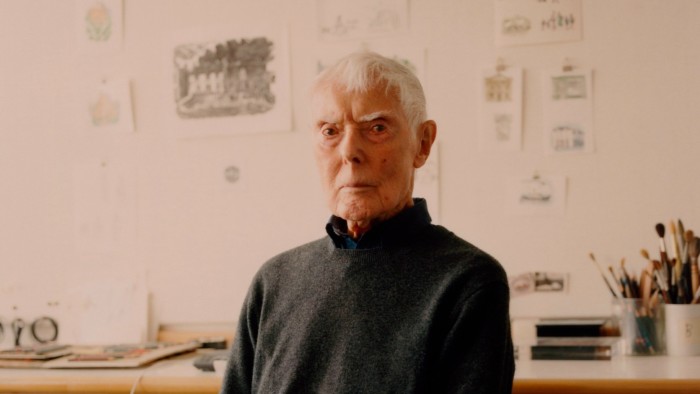Unlock the Editor’s Digest for free
Roula Khalaf, Editor of the FT, selects her favourite stories in this weekly newsletter.
When David Gentleman left art college in 1953, he was adamant that he would never want to teach anyone how to draw. “I didn’t like teaching because it stopped me drawing or designing,” he says, his lean frame perched on a stool in the fifth-floor studio of his Victorian townhouse in Camden, London, where he still works, aged 95.
Instead, he has lived commission to commission. His most impactful designs include changing Queen Elizabeth’s image on British postage stamps from a portrait to a silhouette and creating the Charing Cross Northern Line mural, which shows medieval craftsmen making the Eleanor Cross. He also wrote and illustrated several travel books, taking him from the UK’s coastal towns to Paris and Delhi.
Now, though, he has relented, in the hope of encouraging others to strike out on their own artistic path. In Lessons for Young Artists, Gentleman distils more than seven packed decades into an inspiring primer for the hobbyist and art school graduate alike.
“Anyone can call themselves an artist but if you’re going to earn your living by it, you’ve just got to hope and to stick at it. It’s always been the thing that I’ve most wanted to do,” he says.
Born in Brentford in 1930, Gentleman has used his trademark pen-and-ink with a watercolour wash to capture London countless times, especially Primrose Hill and Regent’s Park. The tree-filled view from his desk is also familiar from any number of his books, most recently My Town (2020), a paean to London that was published as the world was locking itself away at the outset of the pandemic. He is renowned, too, for his paintings of Suffolk, captured in his 2014 book, In the Country — he and his wife, Sue, had a house in the village of Huntingfield for many years. “Suffolk fields and clouds were an automatic thing to draw. I love those images,” he says.

Start small and get on with it are his first lessons, preferably with a pencil, ideally outside. Pencils “might seem a bit dull, but they are so easy to use, and so useful,” he writes.
“Just have a go and try not to worry if it’s not working. Confidence is the key thing. Without it, you don’t draw,” he tells me, adding: “I would draw from one of my photos if I had to, but I would much rather draw from the thing itself. It’s better.”
Gentleman learnt from John Nash and Edward Bawden, who taught him at the Royal College of Art’s design school. “They were very encouraging and I admired their work,” he says. A favourite childhood book was Well on the Road (1935), illustrated by Bawden and written by Christopher Bradby. “I remember lying on the floor and turning the pages. I knew it extremely well,” he says. One of Bawden’s pen-and-ink drawings (“a gift”), of a building near London’s old Billingsgate fish market, hangs on his living room wall.

But when Gentleman noticed echoes of Bawden’s work cropping up in his own, he tried to avoid it. “I wanted my work to be original rather than an imitation of someone else’s,” he writes. He encourages others to find their own style rather than mimicking his.
Other tips in Lessons for Young Artists include embracing mistakes; looking at subjects from an unusual angle; juxtaposing the beautiful with the ugly; and going to exhibitions. “You get inspiration and can enjoy [the artist’s] confidence. I always learn something when I see an exhibition,” he says. The trick is not trying to see everything. “It’s better just to see a few paintings at a time.”

Visiting Gentleman’s house, where he has lived with Sue since 1970, is like stepping inside an exclusive gallery. The walls up to his studio are lined with his own watercolours and those by his father, Tom, who was also an artist-designer, latterly for the then joint venture, Shell-Mex and BP. David’s campaigning National Trust posters are prominent, too, notably against a proposed bypass that would have cut through the historic Petworth Park in West Sussex, a favourite backdrop for many of Turner’s paintings.
His parents met at Glasgow School of Art and his mother, Winifred (née Murgatroyd), was a sensitive oil painter. An interior kitchen scene, painted by his mother and reproduced in Lessons for Young Artists, hangs in the Gentlemans’ ground-floor living room. “As a boy, I loved the shine on that brass pan,” he says, gesturing to the image. “She was very clever. But she was just too busy later on, looking after us, to paint.”
Above all, Gentleman encourages those wishing to pursue an artistic life to keep going. “The only way to become an artist is to do it,” he writes. “It can’t be wished on you.”
‘Lessons for Young Artists’ by David Gentleman is published by Particular Books on July 10
Join our online book group on Facebook at FT Books Café and follow FT Weekend on Instagram, Bluesky and X




